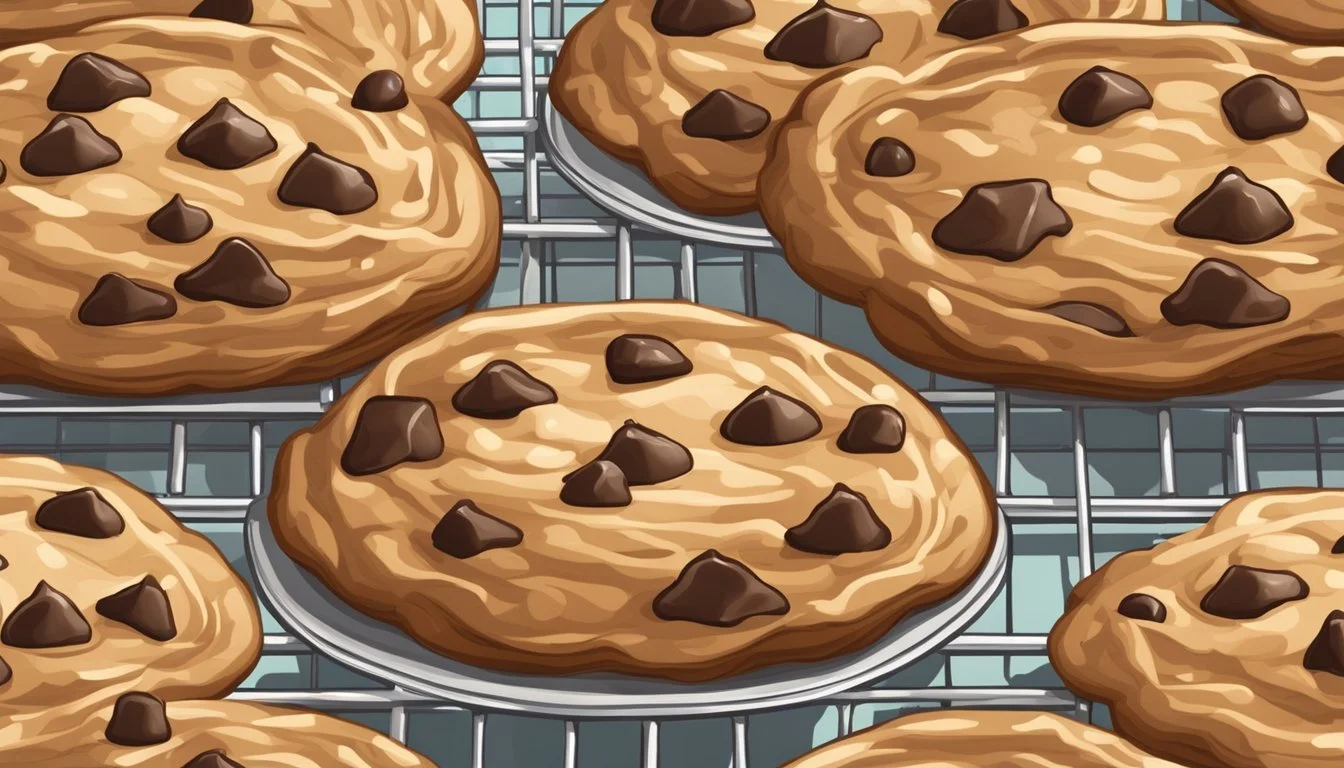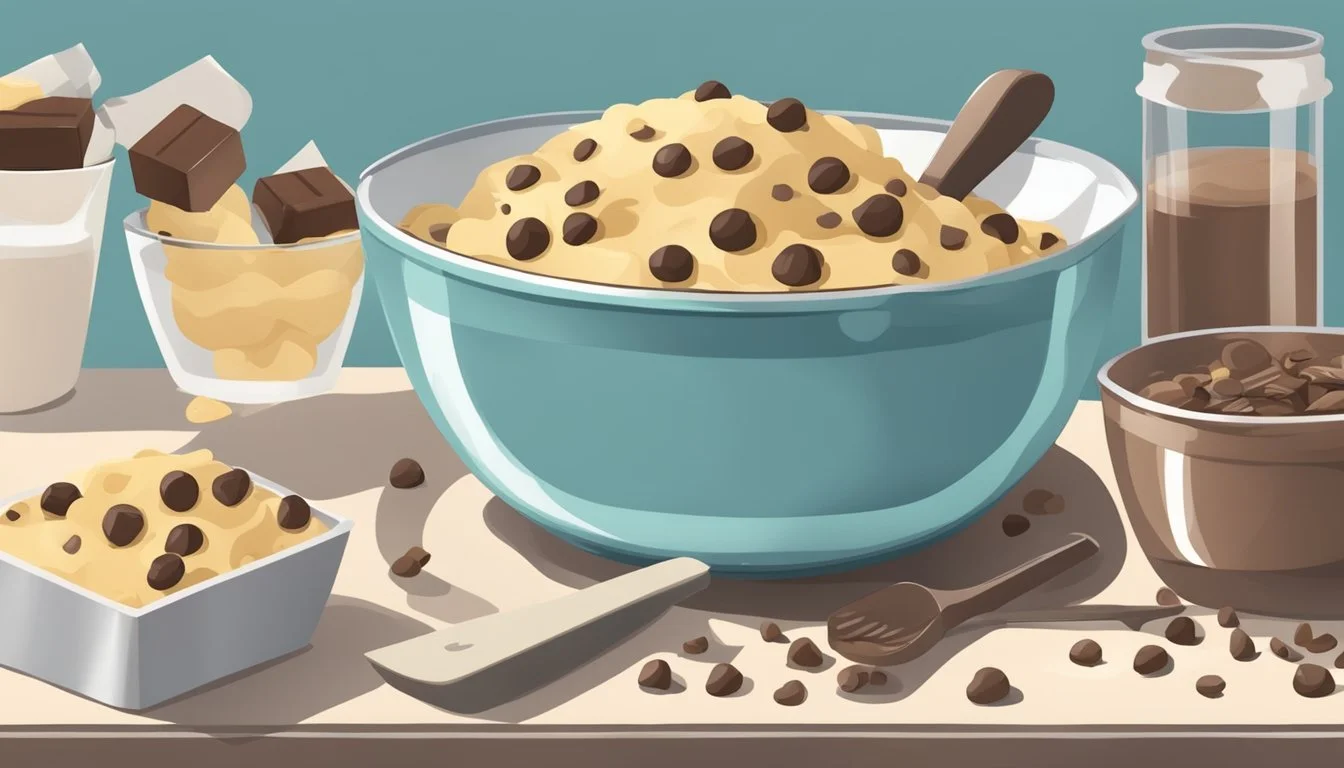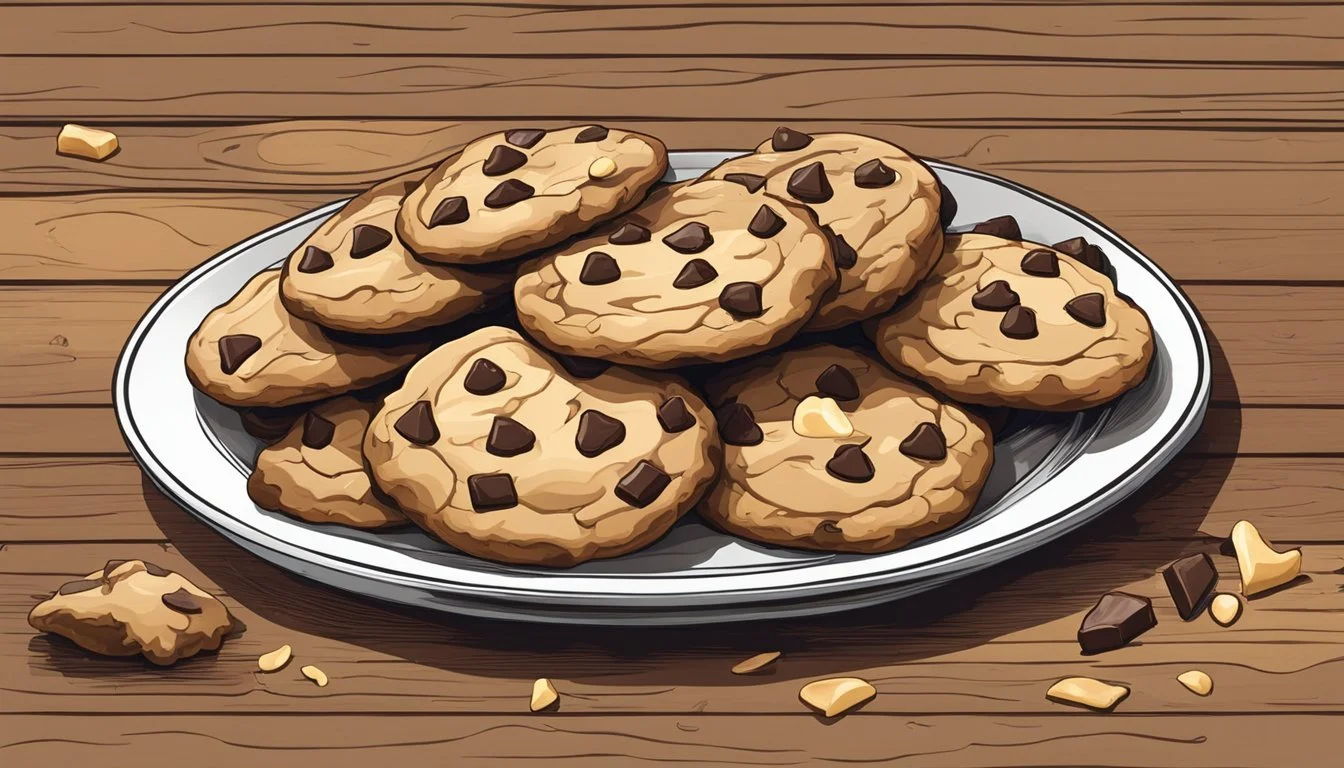Soft & Chewy Chocolate Chip Cookies Recipe
The Ultimate Recipe Guide
Discover > Healthy Living Through Food > Soft & Chewy Chocolate Chip Cookies: The Ultimate Recipe Guide
Soft and chewy chocolate (What wine goes well with chocolate?) chip cookies are a timeless classic that has captivated sweet tooths for generations. These cookies strike the perfect balance between tender and gooey, with just enough structure to hold together those delectable morsels of chocolate. Achieving that hallmark texture comes down to the right combination of ingredients, mixing technique, and baking time. When done correctly, these homemade chocolate chip cookies emerge from the oven with a soft center, chewy edges, and a taste that beckons for a cold glass of milk.
Chocolate chip cookies come in a variety of styles, but the quest for the best chocolate chip cookies often leads bakers down the path to perfecting the soft and chewy variety. This type of cookie is distinguished by its moist and tender crumb, which is usually a result of higher moisture content from ingredients such as brown sugar (how long does sugar last?) and butter (how long does butter last?). Each bite melds the rich, buttery dough with the chocolate chips (how long do chocolate chips last?), creating a harmonious and indulgent experience.
For those eager to craft their own ultimate chocolate chip cookies at home, the process is surprisingly straightforward. Start by gathering your ingredients, like the chewiest chocolate chip cookie recipe that involves a ball of dough made in a mixing bowl. Use a kitchen scale for precise measurements, ensuring the perfect balance of flavors. In a medium bowl, blend the ingredients to achieve a delightful combination that results in cookies with chewy centers. Employ a medium cookie scoop to shape uniform balls of dough, placing them on a baking sheet for even cooking. The kitchen scale ensures accuracy in portioning, contributing to the consistency of each cookie. As the cookies bake, the aroma will fill your home, creating a warm and inviting atmosphere that's as comforting as the delicious chocolate chip cookies themselves.
Essential Ingredients
Creating the perfect batch of soft chocolate chip cookies depends on a precise balance and quality of essential ingredients. Start with your favorite recipes and consider incorporating extra chocolate chips for an added burst of flavor. Use high-quality chocolate bars (how long do chocolate bars last?) or semisweet chocolate chips to enhance the richness of the cookies.
To ensure a soft texture, employ the assistance of an electric mixer in combination with a rubber spatula for thorough mixing. Prepare your baking sheet with either silicone baking mats or a parchment-lined baking sheet to prevent sticking. This attention to detail in both ingredients and preparation will result in cookies with a soft texture that remains delightful even after cooling. Experimenting with these elements will help you perfect your recipe for irresistibly soft and chewy chocolate chip cookies.
Flour Basics
Flour (how long does flour last?) provides the fundamental structure of chocolate chip cookies. Ideally, all-purpose flour is used for its balanced protein content that ensures enough gluten formation to keep the cookies together without making them tough. The proteins in flour, when mixed with liquids, develop into gluten, which traps air and gas, giving the baked cookies their characteristic height and shape.
The Role of Sugars
Sugars not only sweeten the cookies but also affect their texture. Granulated sugar, which is pure sucrose, creates a crisp edge, while brown sugar, containing molasses (how long does molasses last?), imparts a deep flavor and chewiness due to its moisture content. A combination of the two can be used, with light brown sugar being preferable for a softer texture.
Brown Sugar: Adds moistness and chewiness.
Granulated Sugar: Provides crispness and helps in spreading.
Fats and Their Functions
Unsalted butter is typically recommended to control the sodium content and enhance the rich flavor of the cookies. Butter's role is twofold: it aids in creating a tender crumb and, through the creaming process with sugars, introduces air pockets that contribute to leavening. The fat content in butter is also crucial for the desirable tender and chewy texture as it coats (how long do oats last?) the flour proteins, inhibiting too much gluten formation.
Unsalted Butter: Controls sodium and adds flavor and texture.
Eggs and Vanilla
Eggs perform several roles: they offer structure, leavening, and flavor, and act as a binding agent for the dough. Vanilla extract provides a subtle background flavor that complements the chocolate. For the cookies to maintain their softness and moisture, the proportion of eggs is crucial.
Eggs: Structure, leavening, flavor, and binding.
Vanilla Extract: Adds depth of flavor and aroma.
Consistent measurement and quality of these essential ingredients are key in achieving the perfect soft and chewy chocolate chip cookies that are both flavorful and texturally pleasing.
Recipe Overview
Soft and chewy chocolate chip cookies are a classic treat beloved by many. A successful recipe combines the right balance of ingredients to create a cookie that's both tender and satisfyingly chewy. The key to achieving this texture lies in the use of melted butter, which imparts a denser consistency than creamed butter.
Ingredients:
For these indulgent cookies, the following ingredients are essential:
Butter: 1 cup, melted and cooled to room temperature
Sugar: 1 cup white sugar and 1 cup brown sugar, for sweetness and moisture
Eggs: 2 large, at room temperature to incorporate easily
Vanilla Extract: 2 tsp, for a rich flavor
Dry ingredients include:
All-Purpose Flour: 3 cups, the base structure of the cookie
Baking Soda: (how long does baking soda last?) 1 tsp, to help the cookies rise slightly
Salt: 1/2 tsp, to balance the sweetness
And most importantly:
Chocolate Chips: 2 cups, semi-sweet or milk, depending on preference
Method:
The chocolate chip cookie recipe involves a simple process:
Wet Ingredients: Whisk the melted butter and sugars together. Add in the eggs and vanilla extract, mixing until well combined.
Dry Ingredients: In a separate bowl, sift together the 3 cups flour, a teaspoon baking soda, and a half teaspoon of salt.
Combine: Gradually mix the dry ingredients into the wet mixture until just combined. Fold in the chocolate chips.
Chill: It's important to chill the dough for at least 30 minutes. This step is crucial for preventing overspreading and contributes to the cookies' chewy texture.
Bake: Scoop the dough onto a baking sheet, and bake at 350°F (175°C) until golden brown on the edges.
Time and attention to detail ensure that soft and chewy chocolate chip cookies come out perfectly every time.
Mixing and Preparing Dough
The foundation of soft and chewy chocolate chip cookies is in the preparation of the dough, which begins with the creaming of butter and sugar and is followed by incorporating dry ingredients. Once you have your chocolate chip cookie dough ready, ensure you've prepared baking sheets with parchment paper. To achieve those chewy cookies, scoop the dough into balls and place them on the prepared baking sheets.
For an extra twist, consider using both white chocolate chips (how long do white chocolate chips last?) and dark chocolate chips in the dough. As these cookies bake, the aroma will fill your kitchen, creating an inviting atmosphere. The result? Warm cookies with a perfect blend of textures and flavors, make this popular cookie recipe a delightful treat for any occasion.
Creaming Butter and Sugar
One begins by taking butter at room temperature and combining it with sugar in a stand mixer equipped with a paddle attachment. The mixture should be beaten until it is light and fluffy; this process incorporates air and aids in producing a tender texture in the final cookie.
Ingredients:
Butter (room temperature): 1 cup
Granulated sugar: 3/4 cup
Brown sugar: 3/4 cup
Procedure:
Ensure the butter is soft but not oily.
Beat on medium speed for approximately 5 minutes.
Incorporating Dry Ingredients
After creaming, one should gradually add the dry ingredients to the wet mixture. This should be done at a low speed to avoid overmixing, which can affect the texture of the cookies.
Ingredients:
All-purpose flour: 2 1/4 cups
Baking soda: 1 teaspoon
Salt: 1/2 teaspoon
Procedure:
Sift together flour, baking soda, and salt.
Add to the creamed mixture in increments.
Mix until just combined.
After the dough is formed, it is often recommended to chill the dough for at least 30 minutes, which makes handling easier and helps in achieving a chewier texture upon baking.
Baking Techniques
Mastering the precise control of heat and understanding the baking surface is crucial for the perfect batch of soft and chewy chocolate chip cookies.
Preheating and Temperature Control
Before one begins mixing ingredients, it's essential to preheat the oven. A consistent oven temperature ensures that the cookies bake evenly. The typical range for baking chocolate chip cookies is between 350°F to 375°F. An oven thermometer can be used to verify that the internal temperature matches the setting. Temperature fluctuations can result in unevenly baked cookies, where some might be overdone while others remain doughy.
Temperature Monitoring:
Preheat the oven at least 15 to 20 minutes before baking.
Use a reliable oven thermometer to check accuracy.
Standard baking temperature: 350°F (175°C).
Additionally, incorporating baking soda necessitates precision. It acts as a leavening agent, reacting to temperature and moisture to create tiny gas bubbles, which make cookies rise and become fluffy. For it to effectively do its job, the dough should not be exposed to persistently high or low temperatures.
Baking Surfaces
The choice of the baking surface directly affects the outcome of the cookies. Parchment paper is recommended as it prevents sticking and ensures a uniform bake by distributing heat evenly. For a crispier bottom, one might opt for directly baking on a preheated cookie sheet, while parchment paper tends to yield softer bottoms.
Comparison of Surfaces:
Parchment paper: Even bake, easy release, no additional grease needed.
Preheated cookie sheet: Potential for crisper bottoms, requires greasing or non-stick spray.
It's also beneficial to allow cookies to cool for a few minutes on the cookie sheet before transferring them to a wire rack. This helps them set properly without continuing to cook from residual heat. The wire rack then ensures they cool evenly without becoming soggy from trapped steam.
Cooling: Let sit for 2-4 minutes, then transfer to a wire rack for complete cooling.
Finishing Touches
Proper cooling and storage are crucial in maintaining the quality and taste of soft and chewy chocolate chip cookies. The integrity and longevity of the cookies can be preserved when given the right attention after baking.
Cooling and Storage
Once removed from the oven, cookies should be left on the baking sheet for a few minutes to set before transferring them to a cooling rack. This allows them to firm up enough to prevent breakage. After cooling to room temperature, storage is the next important step to ensure freshness.
Airtight Container: To retain softness and prevent drying out, cookies should be stored in an airtight container. Layers of cookies can be separated by parchment paper to prevent sticking.
Chilling: If not consumed immediately, cookies can be chilled in the refrigerator in the container to prolong their quality.
Cookies: Last up to 3 months. Thaw at room temperature before serving.
Dough Balls: Ideal for 2 months. Bake without thawing for fresh cookies.
Sliced Dough: Can last up to 6 months. Thaw slightly, then bake for perfect results.
To free up future baking time, one can freeze cookie dough. Dough balls can be placed on a baking sheet and frozen until solid, then transferred to a freezer bag or container. Alternatively, slice-and-bake cookie dough logs may be wrapped in plastic and frozen. Each retains freshness and makes for convenient future baking sessions.
Variations and Tips
In pursuit of the perfect cookie experience, one can experiment with various ingredients and baking techniques. Below are specific suggestions for add-ins and adjustments to affect the texture and flavor of your cookies.
Alternative Add-Ins and Flavors
Semi-Sweet Chocolate Chips: A classic choice, semi-sweet chips provide a balanced chocolate flavor.
Chocolate Chunks: For those who crave more chocolate in every bite, replacing chips with chunks can enhance the richness.
Pure Vanilla Extract: Using pure extract rather than imitation adds a subtle depth of flavor.
Peanut Butter Chips: To create peanut butter (how long does peanut butter last?) chocolate chip cookies, substitute some of the chocolate chips with peanut butter chips.
Oats: Mix in oats to transform your cookies into oatmeal chocolate chip cookies. This not only changes the flavor but also adds a chewy texture.
Raisins: For a twist on oatmeal raisin cookies, combine both raisins (how long do raisins last?) and chocolate chips.
Texture Modifications
Cornstarch (how long does cornstarch last?): Incorporating a teaspoon of cornstarch helps prevent spreading and leads to a softer cookie.
Extra Egg Yolk: Adding an extra egg yolk increases moisture, which helps create a chewier cookie.
Moisture Control: For a crispier texture, reduce the moisture by slightly decreasing the egg or other liquid components.
Baking Time: Shorten the baking time for softer cookies or extend it for crispier cookies. Monitoring closely is key to achieving the desired texture.
Understanding Cookie Science
In the realm of baking, soft and chewy chocolate chip cookies are a cherished result of precise science. The foundation of any cookie, including the chocolate chip variety, is flour. It provides structure due to the gluten proteins, which, when mixed with liquid, create the framework for the cookie's texture. For a chewier cookie, a higher protein content in the flour, like bread flour (how long does bread flour last?), can be used.
Salt is not merely a flavor enhancer. It also balances sweetness and can affect gluten structure, contributing to the texture. A small pinch can make a significant impact.
When it comes to sugars, the type and ratio are crucial. Brown sugar contains molasses, providing moisture and a chewy texture, while white sugar helps in spreading and crispiness. A higher ratio of brown to white sugar will yield a moist and chewier cookie.
Melted butter versus softened plays a role as well. Melted butter leads to denser, chewier cookies, as opposed to creamed butter, which incorporates air for a lighter, cakier texture.
Cookie dough's chill time affects the final texture significantly. Chilled dough prevents cookies from over-spreading, leading to a thicker, chewier center.
Baking tools such as scales and measuring cups ensure precise ratios for consistency. An oven thermometer guarantees the right baking temperature, which is critical for the perfect bake.
Cakey cookies employ more raising agents and sometimes more flour for a lighter crumb, while chewed chocolate chip cookies benefit from less leavening and might use bread flour for an extra chew.
Differing recipes like snickerdoodles or shortbread cookies tweak these essential elements to create their unique textures and flavors, such as cream of tartar (how long does cream of tartar last?) in snickerdoodles for tanginess and softness, or a higher butter content in shortbread for a delicate crumble.
Health and Dietary Information
Soft and chewy chocolate chip cookies are a well-loved treat. However, individuals should be aware of their calorie content and nutritional impact. On average, a single homemade chocolate chip cookie may contain about 200 calories. The protein content per cookie is relatively low, generally in the range of 2-3 grams, depending on the recipe used.
One must also consider the sugar content in these cookies. While traditional recipes call for a substantial amount of sugar, variations are available to reduce this component, such as using sugar alternatives or cut-out sugar cookies which are made with reduced sugar amounts. It's important to note that modifications to reduce sugar can alter the taste and texture of the cookies.
When choosing to indulge, here are recommended strategies for those conscious of their dietary intake:
Moderation: Enjoy cookies in small quantities to keep calorie and sugar intake in check.
Recipe Adjustments: Try using whole wheat flour (how long does whole wheat flour last?), less sugar, or sugar substitutes.
Protein Increase: Add nuts (how long do nuts last?) or protein powder (how long does protein powder last?) to the recipe to enhance the protein content.
Below is a brief nutritional breakdown for those monitoring their diet:
Calories: Around 200
Protein: 2-3g
Sugars: Varies
Health-conscious individuals may seek out recipes that are tailored to their dietary needs, such as gluten-free, vegan, or low-carbohydrate alternatives, which are increasingly available. Always check the packaging or recipe information for specific nutritional details if one is purchasing premade cookies or following a particular recipe.
Reader Engagement
When it comes to soft and chewy chocolate chip cookies, reader reviews play a crucial role in spreading the word about quality recipes. Enthusiastic home bakers often search for personal testimonials and star ratings before committing to trying a new recipe. Reviews not only build credibility but also provide a platform for bakers to share their experiences and tips for achieving the perfect cookie texture.
For homemade cookies aficionados, engaging with a recipe can mean adjusting ingredients or baking times to suit personal preferences. Feedback from readers who experiment with different types of sugar or flour can help others refine the recipe to their taste, especially when aiming for that soft center and slightly crisp edge.
While chocolate chip cookies are universally beloved, discussions around shortbread can surface in reviews as well. Some readers might compare textures or propose creating a blend of chocolate chip and shortbread styles, which highlights the community’s creativity and passion for baking.
To foster reader engagement, make use of:
Questions: Ask readers how they adjusted the recipe.
Polls: Gather data on common ingredient substitutions.
Photos: Encourage readers to post images of their cookie creations.
Tips Section: Share a bullet list of baking tips and invite readers to contribute:
Preheat your oven accurately.
Measure ingredients correctly.
Chill the dough for a thicker cookie.
These interactive elements not only guide readers through the baking process but also create a dynamic community around the love of soft and chewy chocolate chip cookies.








